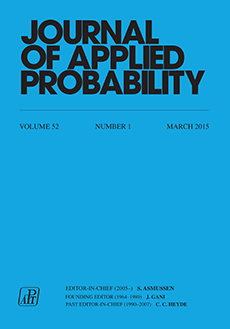Abstract
We study the Bayesian disorder problem for a negative binomial process. The aim is to determine a stopping time which is as close as possible to the random and unknown moment at which a sequentially observed negative binomial process changes the value of its characterizing parameter p ∈ (0, 1). The solution to this problem is explicitly derived through the reduction of the original optimal stopping problem to an integro-differential free-boundary problem. A careful analysis of the free-boundary equation and of the probabilistic nature of the boundary point allows us to specify when the smooth fit principle holds and when it breaks down in favour of the continuous fit principle.
Citation
Bruno Buonaguidi. Pietro Muliere. "On the disorder problem for a negative binomial process." J. Appl. Probab. 52 (1) 167 - 179, March 2015. https://doi.org/10.1239/jap/1429282613
Information





